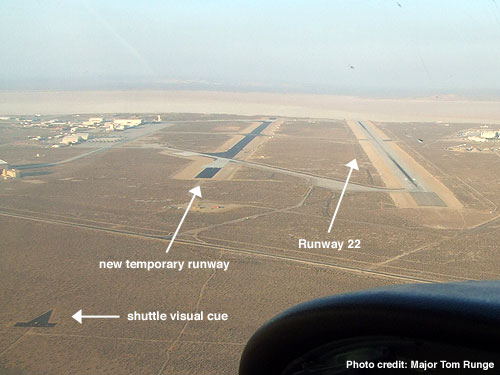Main runway is now completed 4 months ahead of scheduleTeam Edwards finished construction on the main runway Sept. 19, four months after it became inoperative.
In June 2008, a groundbreaking ceremony for the runway construction took place, with completion originally scheduled in December.
"When Edwards' first paved runway was poured more than 50 years ago, people could not have imagined the rich history and flight test heritage that would follow," said Maj. Gen. David Eichhorn, Air Force Flight Test Center commander. "Today, it's inspiring to know, we can only imagine what this runway will see from hypersonic vehicles and beyond."
The runway replacement initiative began in 1997 when pavement evaluations initially indicated possible problems. Ensuing evaluations over the next several years provided the data and trend analysis, proving that the runway was failing at an increasing rate.Planning, programming, budgeting and designing then had to be done for construction to begin on the runway.
"While some organizations and individuals played larger roles than others, virtually the entire installation along with local Congressional delegations, headquarters Air Force Materiel Command, contractors and NASA Dryden Research Center were involved with getting the runway construction started." said James Judkins, 95th Civil Engineering and Transportation Directorate base engineer.
The $118 million project was headed by the U.S. Army Corps of Engineers and included work by Joint Venture, CH2M Hill Construction and the Interstate Highway construction team.
"With the main runway back, it restores full mission capability, allowing us to conduct flight operations that weren't possible without the 15,000-foot long runway." Mr. Judkins said. "I'm extremely happy that we got the runway done as quickly as we did, but I'm not really surprised. I know the project team, and I expected nothing less from them."
According to Mr. Judkins, the teamwork the construction team demonstrated and their open lines of communication enabled them to complete this project ahead of schedule.
Despite its early finish, the team encountered many obstacles during the construction that hindered its completion. The most challenging obstacle was finance. The cost of concrete and steel escalated 26 percent between the time the project was sent to Congress for approval and award of the design and building contract. But with the support of the base, local community and the Air Force's knowledge of the condition of the runway, they were able to get 14 percent more money than originally granted, said Mr. Judkins.
General Eichhorn, together with the Air Base Wing and Test Wing commanders, will perform the first flight off the runway Oct. 31 to commemorate its completion and its first operational use.













